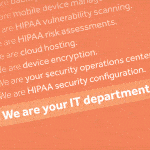Do you remember what your 4th-grade teacher’s hair looked like?
A brunette beehive, right?
Do you remember what she wrote on your report card?
Didn’t think so.
That’s because we process text in our short-term memory and visuals in our long-term memory, according to Vidyard‘s Marketing VP Tyler Lessard.
Also, with our high-speed, distracted way of life, visuals are more memorable because we process them 60,000 faster than we process text (Tyler Lessard).
Take this example – what’s more effective, A or B?
A. “The purse-carrying woman attemped to take the stairs to the shopping mall basement, but took the trippy, stumbly route instead, ending in the ultimate face plant.”
OR
B.
You don’t have to answer that.
But we’re willing to bet that B evoked some emotions that A didn’t. Videos tend to tell better stories than text or photos because watching them uses more senses, and, if you’re watching a video with people in it, facial expressions and body language typically evoke emotion and can also be more relatable. This is probably why more than 20 billion videos are played every day on Snapchat and Facebook and why more than 25 billion hours of video are watched on YouTube every day. This is also probably why your brand should invest in a video camera today.
How can we use video in marketing and sales?
Because video is easier to process and store in our memories, it can be a successful marketing tool.
Here are 5 ways to use video in place of regular business practices.
1. Send a sales video.
Stop pestering your clients and potential clients with boring old sales-pitchy emails. Create some visual appeal with a video email that demonstrates your product or service.
For this fall product preview, Kyla might’ve emailed this video to potential buyers rather than simply emailing them the new menu items:
2. Post video testimonials.
On your website, mix in video testimonials with quotes from satisfied clients. Optimum Productions suggests that “viewers get a first-hand account of the excitement in your customer’s eyes and hear the excitement in their voice.” This can build trust with the brand.
Watch this convincing testimonial for LeafGuard and tell me you’re not on board with Larry:
3. Create a homepage video.
According to Wyzowl’s study of video marketing from 2016, 69% of users would prefer to watch video to learn about a product or service. And what’s more, 77% of users say that a video has convinced them to go on to buy a product or service. Using an explainer video can be more visually interesting to your customers; even a simple video in the background of your homepage is more engaging than static images and text. For a slick example, visit V12 Data’s homepage.
4. Deliver a call-to-action.
Snapchat ads are viewed anywhere from 500,000 times a day to a million times a day, so why not use that to your advantage? Drop in a call-to-action so the customer engagement doesn’t end when the snap ends.
Gametime sure has it figured out:
5. Tell a story about your company.
Use a video to take people behind the scenes at your office, a company event, or an out-of-town conference. Post it on YouTube and create a short version for Instagram. Check out our experience at INBOUND17, for example:
Do you trust us as authorities on HubSpot’s annual INBOUND conference now? Maybe not as much as you’d trust a HubSpot employee, but also maybe more than you’d trust someone who merely wrote a blog post or Tweeted about it.













